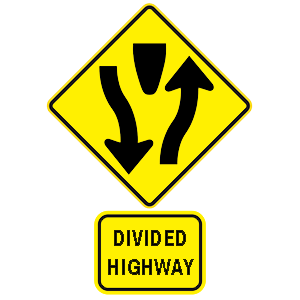2025 Nevada Permit Test 19
The following questions are from real DMV written tests. These are some of the actual permit questions you will face in Nevada. Each permit practice test question has three answer choices. Select one answer for each question and select "grade this section." You can find this button at the bottom of the drivers license quiz. For a complete list of questions and answers for Nevada please visit https://cheat-sheets.dmv-written-test.com/en/nevada/car.
Number of Tests
Number of Question
Passing Score
1. This sign means:

Explanation
Warning signs are usually diamond-shaped with black markings on a yellow background. They alert drivers to upcoming hazards. This warning sign indicates that drivers are about to encounter a divided highway.
2. Which statement about speed is true?
Explanation
As speed increases, the chance of a fatality increases. If you are moving faster than 80 miles per hour, you have almost no chance of living through a crash. Driving more slowly than other traffic can also be dangerous because other motorists may become impatient and make dangerous moves to pass you.
3. If conditions are unsafe, you may not leave a child under the age of eight in a vehicle unattended.
Explanation
Never leave a child under the age of eight unsupervised in a vehicle if conditions present a significant risk to the health and safety of the child. The child must be supervised by and within the sight of a person at least 12 years old.
4. When driving in fog, you should use your high beam headlights.
Explanation
You should use your low beam headlights when driving in fog. High beams will reflect back at the driver and lower visibility.
5. If an oncoming driver is heading toward you in your lane, you should:
Explanation
If another vehicle is approaching you head-on in your lane, you should first honk your horn to attract attention. If the other driver does not move over, try to escape to the right. If you swerve left and the other driver corrects at the last instant, you will still crash. If a collision is unavoidable, brake firmly and steadily. Every mile per hour you slow down will reduce the impact.
6. When making a right turn on a green light, you must:
Explanation
Unless a posted sign prohibits it, you may turn right or left at a steady green light. When turning, you must yield to other vehicles and pedestrians within the intersection.
7. If two drivers arrive at the same time to a four-way intersection controlled by stop signs:
Explanation
Yield the right-of-way to the driver on your right at a four-way intersection if you both arrive to the intersection at the same time. You may then proceed when it is safe to do so.
Ranked by best match
